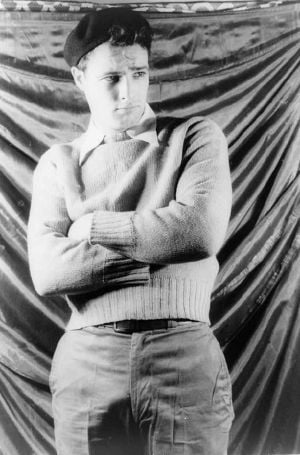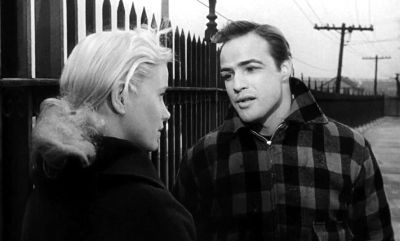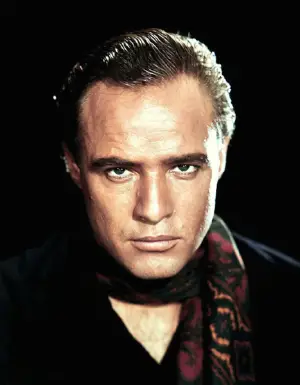Marlon Brando
| Marlon Brando | |
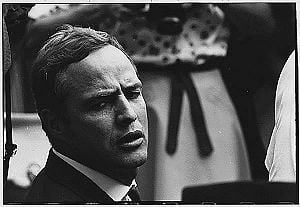 Marlon Brando at the August 28, 1963, Civil Rights March on Washington, D.C. | |
| Birth name: | Marlon Brando Jr. |
|---|---|
| Date of birth: | April 3, 1924 |
| Birth location: | Omaha, Nebraska, |
| Date of death: | July 1, 2004 (Age 80) |
| Death location: | Los Angeles, California, |
| Height: | 5 ft 9 in / 1.75 m |
| Academy Awards: | Academy Award for Best Actor 1955 On the Waterfront 1973 The Godfather |
Marlon Brando, Jr. (April 3, 1924 ‚Äď July 1, 2004) was a prominent American actor who transformed Hollywood with his innovative practice of method acting, inspiring the likes of James Dean and Robert De Niro. He brought the techniques of method acting to prominence in the films A Streetcar Named Desire and On the Waterfront, both directed by Elia Kazan in the early 1950s. He was nominated for Best Actor by the Academy for four straight years for: A Streetcar Named Desire (1951), Viva Zapata (1952), Julius Caesar (1953), and On the Waterfront (1954). Brando won the Best Actor Oscar in 1954 and 1973 (The Godfather).
In the 1960s Brando was one of the first actor-activists to march for civil rights and Native American rights. He refused to accept his Oscar for "The Godfather," in protest of discrimination against Native Americans in the film industry and in government policy.
In 1999 the American Film Institute named him the Fourth Greatest Male Star of All Time. In his latter years he came to be known as much for his bizarre behavior as for his acting.
Early life
Marlon Brando was the youngest of three children born to Marlon Brando Sr. (1895-1965) and Dorothy Pennebaker Brando (1897-1954). His elder sisters were Jocelyn Brando (1919) and Frances Brando (1922). Marlon Brando's childhood was spent in Omaha, Nebraska until 1935 when his parents separated. Dorothy kept all three children and took them to live with her mother in Santa Ana, California. After two years in California, Marlon Sr. and Dorothy reconciled and reunited the family, settling in a small town close to Chicago called Libertyville, Illinois.
Brando's early life was neither stable nor particularly easy. His mother, though known as a talented and kindhearted person, suffered from the effects of alcoholism. She worked long hours and was often gone from home. Dorothy Brando worked at the local theater and is known for helping Henry Fonda begin his acting career. Brando and his sister, Jocelyn, spent many hours at the theater and their mother encouraged an interest in acting. From a young age he was able to mimic many different people.
His childhood was marked by a rebellious nature and he was expelled from his high school in Liberty. As a result his father sent Brando to the Shattuck Military Academy in Faribault, Minnesota when Brando was 16 years old. Marlon Sr. had attended this same school when he was younger. It was at Shattuck that Marlon flourished in theater. He also began to do well in academics, the rigorous structure proving to be just what he needed. During his final year of high school, 1943, his rebellious attitude again got the better of him. He was put on probation for talking back to an officer and expelled for breaking his probation. The students, who loved Brando, were angered and fought for him to come back. The school finally invited him back for the end of his education, but Brando decided not to finish.
Brando left Illinois and moved to New York City. Both of his sisters were living in New York, and Jocelyn had already performed on Broadway. Brando enrolled at the American Theatre Wing Professional School, New School Dramatic Workshop, and the Actors' Studio. While at the New School's Dramatic Workshop, Brando had an experience that would change his life. It was here that he met Stella Adler and studied the methods of the Stanislavski System.
Career
His dedication to method acting landed him a role on Broadway in the 1944 drama I Remember Mama. After much acclaim in the role he followed up by starring in Truckline Café, where he portrayed a disheartened, paraplegic veteran, and although the play was a financial failure, critics voted him "Broadway's Most Promising Actor." His next role as Stanley Kowalski in Tennessee Williams' play A Streetcar Named Desire gave Brando the break that launched him to stardom. The play opened in 1947 and was directed by the famed Elia Kazan. Brando wanted the part so badly that he drove to Provincetown, Massachusetts to give an audition for Williams himself. Williams would later say that as soon as he opened the door, he knew he had his ideal Stanley.
After the success of this play Hollywood came calling at Brando's door. They asked him to do a screen test for Warner Brothers Studios, who then offered Brando a contract for six years. Brando was skeptical about a long term contract so he turned it down. The screen test can be seen on the 2006 DVD release of Streetcar as a special feature. In 1950 he won the role of a bitter and crippled war veteran in The Men and prepared by spending a month in bed at a veteran's hospital.
Brando impressed the cinema-going public the same way he did those who watched him nightly in A Streetcar Named Desire. He won the film role of Stanley Kowalski and worked with director Elia Kazan for the second time. When the film premiered in 1951 Brando received his first nomination for an Academy Award for Best Actor. He went on to receive nominations for his next three roles: Viva Zapata! in 1952, Julius Caesar in 1953, and On the Waterfront in 1954. He finally won on the fourth try while once again working with Kazan. With each new performance Brando gained more respect and his performances were soon hailed as the work of a genius.
In 1953 he also starred in Lee Falk's play Arms and the Man. It would be the last time he ever acted in a stage play. It was a busy year for Brando as he also appeared as Johnny Strabler in The Wild One. His portrayal of a motorcycle rebel set the standard for rebellious characters and found a large audience in the nation's teenage population. The movie had a big impact on the sale of motorcycles, leather jackets, and jeans. Elvis Presley was so impressed by the performance that he imitated Brando's look and character in his rock and roll performances, and also copied the character of Johnny for his character of Vince in the 1957 film Jailhouse Rock.
Throughout the 1950s Brando continued to take on roles that enabled him to challenge himself in many areas. In Guys and Dolls he took on a singing role. In The Teahouse of the August Moon he played a Japanese interpreter named Sakini in postwar Japan. Then he played an Air Force officer in Sayonara and won his sixth Oscar nomination. To finish off the 1950s, Brando played a Nazi officer in The Young Lions.
In the 1960s Brando starred in films such as One-Eyed Jacks (1961), a western that would be the only film Brando would ever direct; Mutiny on the Bounty (1962); Reflections in a Golden Eye (1967), portraying a repressed gay army officer; and Burn! (1969), which Brando would later claim as his personal favorite, although it was a commercial failure. By the end of the decade his career was in decline as his reputation as a difficult star and his long string of commercial failures took a toll on his box-office appeal.
The Godfather
By 1972 Brando had a string of 11 straight commercial film failures. That string was broken with his performance as Vito Corleone in The Godfather. It was director Francis Ford Coppola who convinced Brando to submit to a screen test for a role in his film. He convinced Brando to a videotaped "make-up" test in which Brando did his own makeup (he used cotton balls to simulate the character's puffed cheeks). Coppola was mesmerized by the performance and begged the studio to allow the casting of Brando as the head of the famous crime family. The role resulted in his second Academy Award for Best Actor.
Brando used the occasion of receiving his second Oscar to protest the poor treatment of Native Americans in film and television. He boycotted the ceremony and he sent actress Sacheen Littlefeather to refuse the award on his behalf. (Later she was revealed to be an actress named Maria Cruz, a former winner of the 1970 Miss American Vampire competition.)
Despite his protest, Brando's performance in Last Tango in Paris (1972), directed by Bernardo Bertolucci, was also nominated for best actor.
Superman
As Brando's career declined his demands to appear and his bizarre behavior made more headlines than his portrayals. He demanded a large sum of money for a very small part as Jor-El in the first Superman movie in 1978. His conditions included not reading the script beforehand or auditioning for anyone and his lines had to be written down and displayed on cards off screen.
Brando filmed scenes for Superman II, but when the studio refused to pay him what he asked, he refused permission to use the footage in the film. Thus the world had to wait until Brando's death to see the film as intended by Richard Donner in the 2006 re-cut, Superman II: The Richard Donner Cut. That same footage was also used in the newer version made in 2006 Superman Returns. In addition to the footage used, Brando's recorded voice-overs were used throughout the film.
Final roles
In 1979 he demanded and received one million dollars a week to play Colonel Kurtz in Apocalypse Now. He was supposed to show up slim, fit, and to have read the book Heart of Darkness. He showed up weighing around 220 pounds and had not read the book.
Despite announcing his retirement from acting in 1980, he decided to play supporting roles A Dry White Season (for which he was again nominated for an Oscar in 1989), The Freshman in 1990 and Don Juan DeMarco in 1995 (during which time he met and befriended Johnny Depp). In his final film, The Score (2001), he starred with Robert De Niro.
Activism
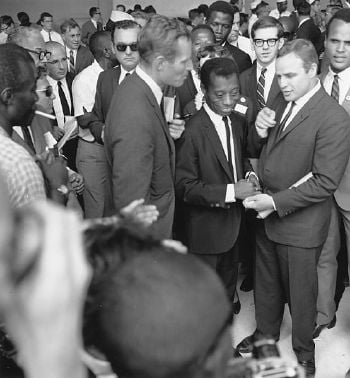
Outside the studios Brando was an activist who participated in the African-American Civil Rights Movement, and the effort to acknowledge Native American rights.
In the early 1960s Brando contributed thousands of dollars to both the Southern Christian Leadership Conference (SCLC) and to a scholarship fund established for the children of slain Mississippi NAACP leader Medgar Evers. By this time, Brando was already involved in films that carried messages about human rights: ‚ÄúSayonara,‚ÄĚ which addressed interracial romance, and the ‚ÄúThe Ugly American‚Äú, depicting the conduct of American officials abroad and its deleterious effect on the citizens of foreign countries.
Shortly after Dr. Martin Luther King, Jr.'s death in 1968, Brando announced that he was bowing out of the lead role of a major film (The Arrangement) in order to devote himself to the civil rights movement. He participated in many marches and boycotts.
Brando also participated in "Free Huey" protests after Black Panther leader Huey P. Newton was tried in 1968 for allegedly killing an Oakland, California policeman.
Personal Life
Marriages
In 1957 Brando married his first wife, actress Anna Kashfi. Brando thought she was of Asian Indian descent, and Anna, knowing that Brando had a reputation for liking exotic women, kept up the charade. In truth, she was an Irish Roman Catholic from Wales named Joan O'Callaghan. The marriage ended in 1959 with the couple having one son, Christian Brando.
In 1960, Brando married another actress, Movita Castaneda, who was seven years older than Brando. They had two children.
In 1962 while filming Mutiny on the Bounty Brando met the Tahitian beauty Tarita Teriipia, who played his love interest in the film. She was 18 years younger than him and became his third wife. He had two children with her.
Brando also had three children with his maid Christina Maria Ruiz who lived with him in the late 1980s and early 1990s.
Brando also adopted three children.
Family tragedies
In 1990 Brando's son Christian was arrested for the murder of his sister's boyfriend, Dag Drollet. He pleaded guilty and received a ten year sentence. The sister he defended, Cheyenne, committed suicide in 1995.
After the deaths of family and friends he fell into depression and became quite obese. He spent the last decade of his life the object of media curiosity.
Final years and death
On July 1, 2004, at 6:30 p.m. local time, Brando died at the age of 80. He died at the UCLA Medical Center of respiratory failure brought on by pulmonary fibrosis. Brando had also been diagnosed with liver cancer, as well as simultaneously suffering from congestive heart failure. In 2006, it was known that Brando had suffered from dementia in the final years of his life.
Brando was cremated and his ashes were scattered in two places. Part of his ashes were scattered in Tahiti and part of his ashes were scattered in Death Valley.
Filmography
- The Men (1950)
- A Streetcar Named Desire (1951)
- Viva Zapata! (1952)
- Julius Caesar (1953)
- The Wild One (1953)
- On the Waterfront (1954)
- Désirée (1954)
- Guys and Dolls (1955)
- Operation Teahouse (1956) (short subject)
- The Teahouse of the August Moon (1956)
- Sayonara (1957)
- The Young Lions (1958)
- The Fugitive Kind (1959)
- One-Eyed Jacks (1961) (also director)
- Mutiny on the Bounty (1962)
- The Ugly American (1963)
- Bedtime Story (1964)
- Morituri (1965)
- The Chase (1966)
- The Appaloosa (1966)
- Meet Marlon Brando (1966) (short subject)
- A Countess from Hong Kong (1967)
- Reflections in a Golden Eye (1967)
- Candy (1968)
- The Night of the Following Day (1968)
- Burn! (1969)
- King: A Filmed Record... Montgomery to Memphis (1970) (documentary)
- The Nightcomers (1972)
- The Godfather (1972)
- Last Tango in Paris (1972)
- The Missouri Breaks (1976)
- Raoni (1978) (documentary) (narrator)
- Superman: The Movie (1978)
- Apocalypse Now (1979)
- The Formula (1980)
- A Dry White Season (1989)
- The Freshman (1990)
- Hearts of Darkness: A Filmmaker's Apocalypse (1991) (documentary)
- Christopher Columbus: The Discovery (1992)
- Don Juan DeMarco (1995)
- The Island of Dr Moreau (1996)
- The Brave (1997)
- Free Money (1998)
- The Score (2001)
- Superman Returns (2006) - Posthumous appearance, appears in archive footage as Jor-El
- Superman II: The Richard Donner Cut (2006)
ReferencesISBN links support NWE through referral fees
- Bosworth, Patricia. 2001. Marlon Brando. New York: Viking. ISBN 0670882364
- Brando, Marlon, and Robert Lindsey. 1994. Brando: Songs my Mother Taught Me. New York: Random House. ISBN 0679410139
- Downing, David. 1984. Marlon Brando. New York: Stein and Day. ISBN 0812829816
- Thomas, Tony. 1973. The Films of Marlon Brando. Secaucus, NJ: Citadel Press. ISBN 080650370X
- Schickel, Richard. 1991. Brando: A Life in Our Times. New York: Atheneum. ISBN 0689121083
- Manso, Peter. 1994. Brando: The Biography. New York: Hyperion. ISBN 0786860634
- Staggs, Sam. 2005. When Blanche Met Brando: The Scandalous Story of "A Streetcar Named Desire". New York: St. Martin's Press. ISBN 0312321643
External links
All links retrieved April 29, 2025.
- Marlon Brando at the Internet Movie Database
- Actor Marlon Brando, 80, Dies The Washington Post
- Behind the scenes - Marlon Brando The Guardian.
| |||||||||||||||||
Credits
New World Encyclopedia writers and editors rewrote and completed the Wikipedia article in accordance with New World Encyclopedia standards. This article abides by terms of the Creative Commons CC-by-sa 3.0 License (CC-by-sa), which may be used and disseminated with proper attribution. Credit is due under the terms of this license that can reference both the New World Encyclopedia contributors and the selfless volunteer contributors of the Wikimedia Foundation. To cite this article click here for a list of acceptable citing formats.The history of earlier contributions by wikipedians is accessible to researchers here:
The history of this article since it was imported to New World Encyclopedia:
Note: Some restrictions may apply to use of individual images which are separately licensed.
